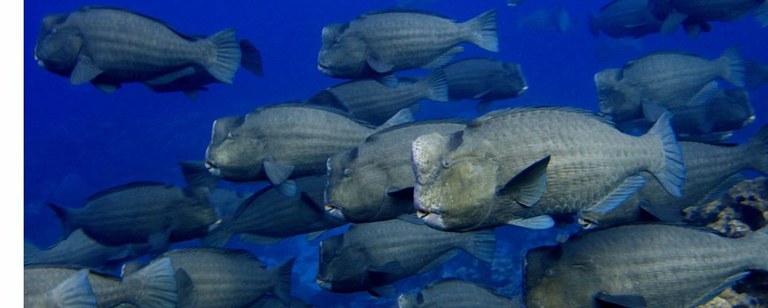From the University of California at Sand Diego:
Scripps Leads First Global Snapshot of Key Coral Reef Fishes
In the first global assessment of its kind, a science team led by researchers at Scripps Institution of Oceanography at UC San Diego has produced a landmark report on the impact of fishing on a group of fish known to protect the health of coral reefs. The report, published in the journal Proceedings of the Royal Society B (Biological Sciences), offers key data for setting management and conservation targets to protect and preserve fragile coral reefs.
Beyond their natural beauty and tourist-attraction qualities, coral reefs offer economic value estimated at billions of dollars for societies around the world. Scripps Master’s student Clinton Edwards, his advisor Jennifer Smith, and their colleagues at the Center for Marine Biodiversity and Conservation at Scripps, along with scientists from several international institutions, have pieced together the first global synthesis on the state of plant-eating fish at coral reef sites around the world. These herbivorous fish populations are vital to coral reef health due to their role in consuming seaweed, making them known informally as the “lawnmowers” of the reef. Without the lawnmowers, seaweeds can overgrow and out-compete corals, drastically affecting the reef ecosystem.
Among their findings, the researchers found that populations of plant-eating fish declined by more than half in areas that were fished compared with unfished sites.
“One of the most significant findings from this study is that we show compelling evidence that fishing is impacting some of the most important species on coral reefs,” said Smith. “We generally tend to think of fishing impacting larger pelagic fishes such as tuna but here we see big impacts on smaller reef fish as well and particularly the herbivores. This is particularly important because corals and algae are always actively competing against one another for space and the herbivores actively remove algae and allow the corals to be competitively dominant. Without herbivores, weedy algae can take over the reef landscape. We need to focus more on protecting this key group of fishes around the globe if we hope to have healthy and productive reefs in the future.”
“While these reef fish are not generally commercial fisheries targets,” said Edwards, “there is clear evidence from this study that fishing is impacting their populations globally.” Edwards, a UC San Diego graduate, recently completed his Masters thesis at Scripps where he said his experience and the opportunities he was given to conduct research were unparalleled.
The researchers also found that fishing alters the entire structure of the herbivore fish community, reducing the numbers of large-bodied feeding groups such as “grazers” and “excavators” while boosting numbers of smaller species such as algae-farming territorial damselfishes that enhance damaging algae growth.
“These results show that fished reefs may be lacking the ability to provide specific functions needed to sustain reef health,” said Edwards.
“We are shifting the herbivore community from one that’s dominated by large-bodied individuals to one that’s dominated by many small fish,” said Smith. “The biomass is dramatically altered. If you dive in Jamaica you are going to see lots of tiny herbivores because fishers remove them before they reach adulthood. In contrast, if you go to an unfished location in the central Pacific the herbivore community is dominated by large roving parrotfishes and macroalgal grazers that perform many important ecosystem services for reefs.”
The authors argue that such evidence from their assessment should be used in coral reef management and conservation, offering regional managers data to show whether key herbivores are fished down too low and when they’ve successfully recovered in marine protected areas.
“This assessment allows us to set management goals in different regions across the globe,” said Smith. “Regional managers can use these data as a baseline to set targets to develop herbivore-specific fisheries management areas. We should be using these important fish as a tool for reef restoration. On reefs where seaweed is actively growing over reefs, what better way to remove that seaweed than to bring back those consumers, those lawnmowers?”
In addition to Edwards and Smith, coauthors include Brian Zgliczynski and Stuart Sandin from Scripps; Alan Friedlander of the U.S. Geological Survey; Allison Green of the Nature Conservancy; Marah Hardt of OceanInk; Enric Sala of the National Geographic Society; Hugh Sweatman of the Australian Institute of Marine Science; and Ivor Williams of the Pacific Islands Fisheries Science Center.
The research was supported by the National Science Foundation and NOAA through the Comparative Analysis of Marine Ecosystem Organization (CAMEO) program.










0 Comments